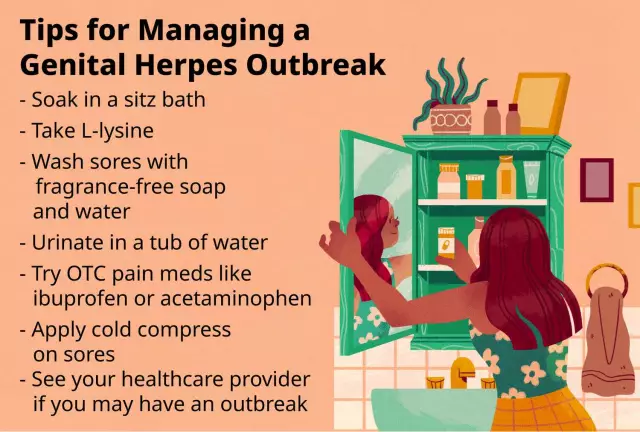- Author Rachel Wainwright [email protected].
- Public 2023-12-15 07:39.
- Last modified 2025-11-02 20:14.
Rhinitis of pregnancy: symptoms, how to treat, how to distinguish it from the usual
The content of the article:
- Symptoms of rhinitis during pregnancy
- Diagnostics
- Treatment of rhinitis during pregnancy
- Video
What you should know about rhinitis during pregnancy: symptoms of the disease, risk factors, developmental features. How to distinguish it from a common cold. What are the main treatments.
Rhinitis of pregnancy is the most common form of vasomotor rhinitis. The disease occurs in about 30% of women. The symptoms of the disease negatively affect the quality of life of the expectant mother.

Various causes can lead to rhinitis during pregnancy.
Predisposing factors that contribute to the development and intensification of rhinitis symptoms during pregnancy:
- traumatic damage to the nose;
- deformation of the nasal septum;
- the presence of polyps, neoplasms in the nose;
- increased blowing out;
- pharyngolaryngeal (gastroesophageal) reflux;
- allergy to pollen of various plants, domestic animals;
- food allergies.
Among the trigger factors, house dust mite allergy and smoking are the most important. Active and passive smoking contributes to exacerbations of allergic and vasomotor rhinitis, as well as bronchial asthma.

House dust is one of the important predisposing factors for the development of the disease.
The mechanism of rhinitis development during pregnancy is not well understood. The main links of pathogenesis:
- an increase in the secretion of hormones: progesterone and estrogen;
- inhibition by estrogens of the enzyme acetylcholinesterase, increased blood levels of acetylcholine;
- expansion and overflow of blood in the cavernous tissue of the turbinates (under the action of acetylcholine);
- the appearance of edema and hypersecretion of the nasal mucosa.
Changes in hormonal levels affect the activity of inflammatory mediators and allergic reactions.
In the first trimester of pregnancy, a woman's body produces a large amount of histaminase, which reduces the level of serum histamine. Therefore, severe forms of rhinitis usually develop from the second trimester. Estradiol and progesterone increase the sensitivity of histamine receptors in the epithelial cells of the nasal mucosa. All these reactions result in nasal hyperreactivity, which underlies the development of disease symptoms.
During pregnancy, changes occur in the woman's immune system that make her more susceptible to viral and bacterial infections, which often leads to purulent inflammation of the paranasal sinuses:
- the activity of T-lymphocytes increases;
- humoral immunity is activated;
- there is a suppression of the cellular link of immunity.
Symptoms of rhinitis during pregnancy
Most often, signs of the disease occur in the second trimester of pregnancy, after childbirth they usually disappear. The main symptoms are sneezing, nasal congestion, and hypersecretion.
Discharge from the nose is clear, watery, but can change with the complication of rhinitis with purulent sinusitis. During pregnancy, women suffer from sinusitis 6 times more often than in the rest of their lives.
Prolonged rhinitis is accompanied by a change in taste and smell. Constant difficulty in nasal breathing leads to disturbed sleep and concentration. Daytime fatigue and headache reduce the quality of life and may contribute to the onset or worsening of the course of concomitant diseases.
Diagnostics
To establish a diagnosis, it is carried out:
- careful collection of anamnesis data;
- dynamic questioning;
- anterior rhinoscopy;
- nasal peak flowmetry;
- rhinomanometry;
- acoustic rhinometry;
- clinical blood test;
- blood test for IgE.

CBC and allergen testing may be required to confirm the diagnosis
During anterior rhinoscopy, the following are determined:
- edema and hyperemia of the nasal mucosa;
- the presence of secretions or crusts on the walls;
- pustules or festering granulomas on the inner surface of the wings of the nose and the anterior sections of the nasal septum (with complicated rhinitis).
How to distinguish vasomotor rhinitis from a common rhinitis? The second is characterized by the presence of symptoms of vegetative-vascular dystonia (low blood pressure, bradycardia, neurasthenia), with rhinoscopy, cyanosis of the nasal mucous membranes is possible, and eosinophilia is often determined in a blood test. Also, the symptoms of vasomotor rhinitis may subside when the ragweed and other plant flowering season passes.
Treatment of rhinitis during pregnancy
Therapy of the disease requires an individual approach, since the symptoms can be caused not only by changes in the hormonal status of the body, but also by many other reasons. A differentiated approach to the treatment of various forms of rhinitis is important.
Treatment of allergic and vasomotor rhinitis during pregnancy should begin with the elimination of factors that contribute to the onset and progression of symptoms of the disease (allergens, irritants).

In order to prevent the development of the disease, it is recommended to use air purifiers and humidifiers.
Preventive measures are being taken to reduce the concentration of house dust allergens in the inhaled air. This requires:
- release the pregnant woman from the duties of cleaning the apartment;
- remove collectors of allergens from the bedroom (carpets, heavy curtains, soft toys, computer, TV);
- use a vacuum cleaner with a dustproof filter when cleaning;
- regularly ventilate the room, use air purifiers and humidifiers.
It is necessary to limit contact with tobacco smoke as much as possible. Nicotine, carbon monoxide contained in it, penetrate through the placenta into the blood of the fetus, which can cause disturbances in its development.
During pregnancy, a woman should limit contact with patients with respiratory infections as much as possible, and visit less public places during influenza epidemics. Rhinitis, which occurs against the background of such an infection, can proceed for a long time and is often complicated by purulent rhinosinusitis.
Vaccination with influenza vaccine is possible from the 12th week of pregnancy.
With the development of infectious rhinitis, it is necessary to consult a specialist. The doctor will tell you how to rinse the nasal cavity with a cold. Chlorhexidine and Miramistin solutions have a good antiseptic effect.
You should endure and not take non-steroidal anti-inflammatory drugs (analgin, aspirin) during pregnancy, as this can cause the development of aspirin bronchial asthma.
There is a close relationship between bronchial asthma and vasomotor rhinitis: when the course of bronchial asthma worsens during pregnancy, the symptoms of rhinitis begin to intensify. This proves the need for adequate therapy for both diseases.
In the third trimester of pregnancy, the already existing gastroesophageal reflux appears or intensifies (reverse reflux of the contents of the stomach into the esophagus and pharynx). This is due to an increase in the size of the uterus and a decrease in the vertical size of the chest. Gastroesophageal reflux contributes to rhinitis symptoms and rhinosinusitis. Proton pump inhibitors (Omeprazole) are used to reduce reflux symptoms.
Which nasal drops can be used during pregnancy and which drugs should be taken depends on the gestational age and the form of rhinitis. Treatment is selected strictly by a specialist and may include:
- antihistamines: Cetirizine, sodium cromoglycate;
- topical corticosteroids (Nazonex, Budesonide);
- vasoconstrictor drugs (Pseudoephedrine).
How to treat rhinitis at home? In addition to the main prescriptions of the doctor, it is possible to irrigate the nasal mucosa with solutions with sea salt (Aqua Maris). Positive reviews confirm a decrease in the severity of rhinitis symptoms with daily rinsing of the nose.
Video
We offer for viewing a video on the topic of the article.

Alina Ervasova Obstetrician-gynecologist, consultant About the author
Education: First Moscow State Medical University. THEM. Sechenov.
Work experience: 4 years of work in private practice.
Found a mistake in the text? Select it and press Ctrl + Enter.






